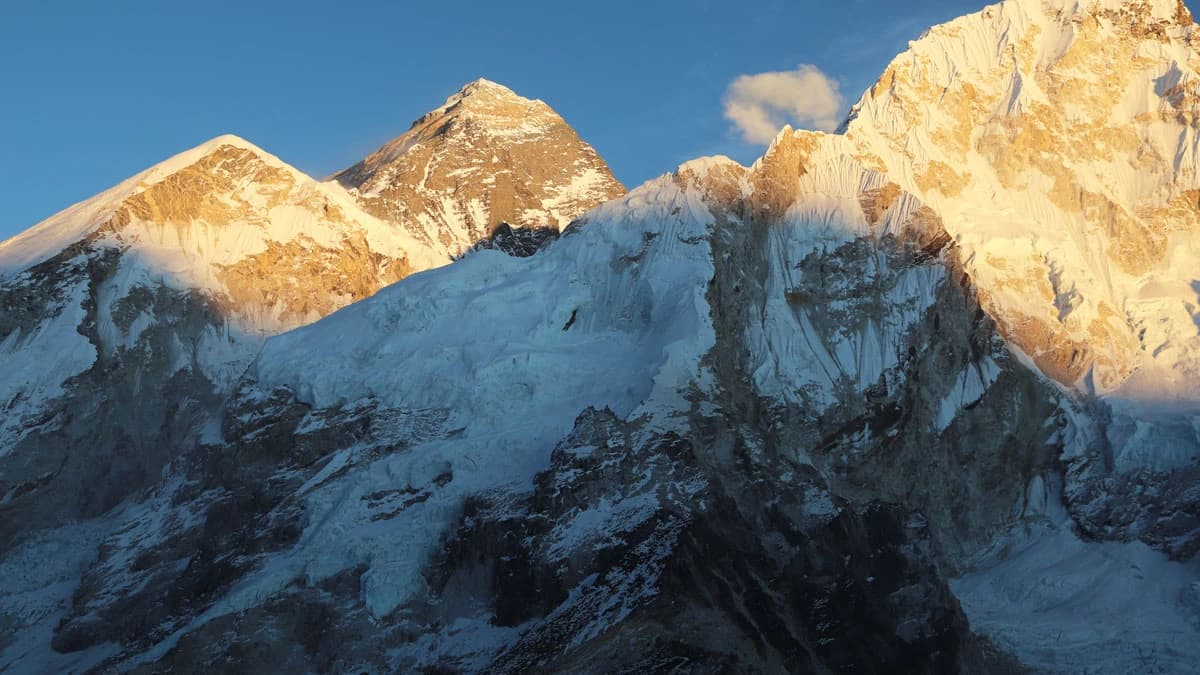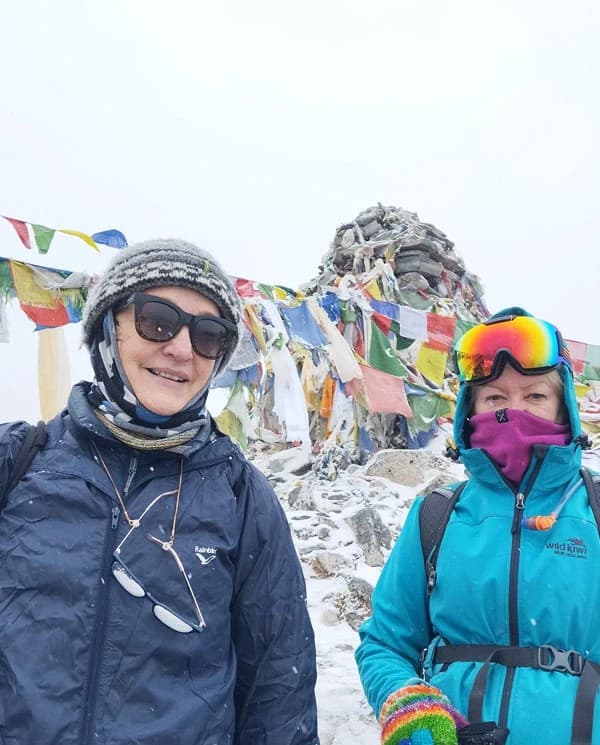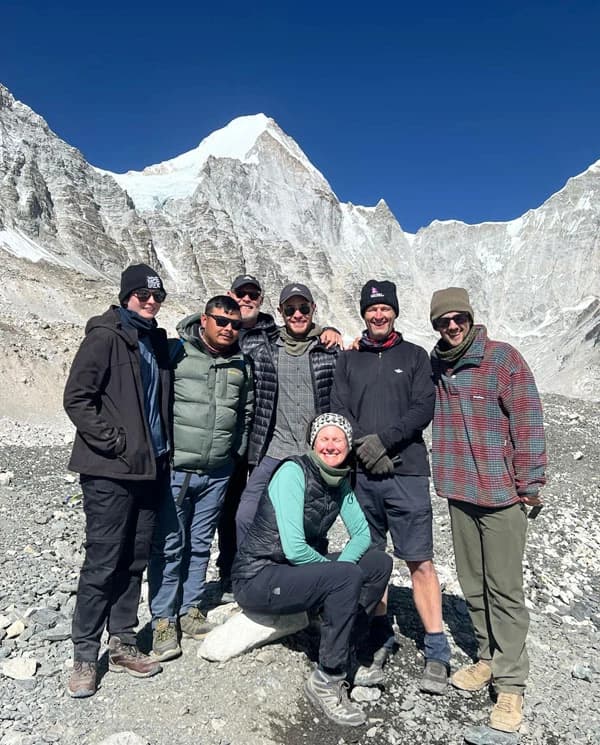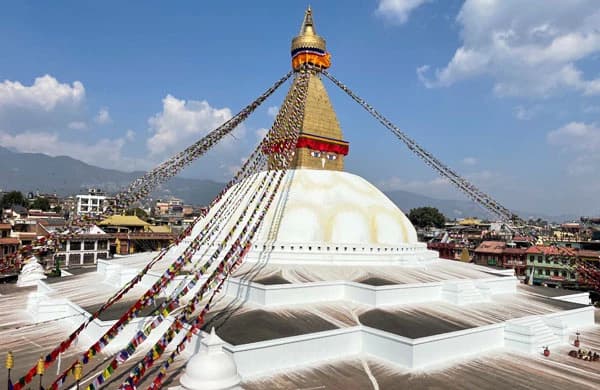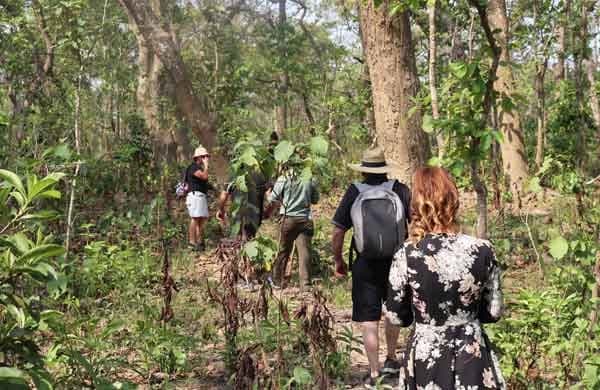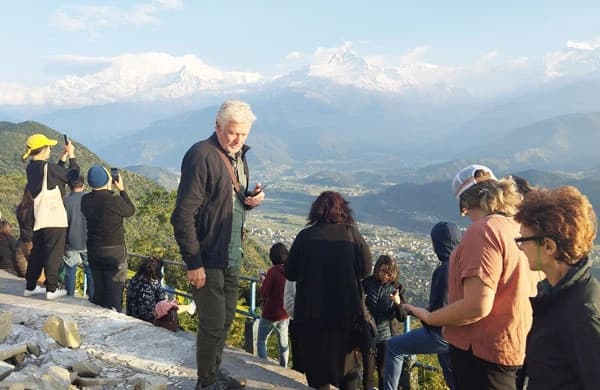Introduction to the Everest Base Camp Trek - 12 Days
The 12 Days Everest Base Camp Trek from Kathmandu is designed for adventurers who want to reach the world's most famous base camp in a shorter timeframe. The EBC Trek from Kathmandu is a perfect blend of adventure, cultural exploration, and breathtaking landscapes. Unlike longer EBC itineraries, the 12-Day EBC Trek's route is carefully crafted to balance trekking, acclimatization, and cultural exploration, making it ideal for travelers with limited time.
Along the Everest Base Camp Trek 12-day itinerary, you'll explore vibrant Sherpa towns like Namche Bazaar, visit ancient monasteries such as Tengboche, and witness stunning Himalayan panoramas. The trek culminates at Everest Base Camp (5,364m) and the sunrise viewpoint of Kala Patthar (5,545m), arguably the best place to see Mount Everest up close.
The Khumbu region is a remote and treasured destination, offering a wealth of unique cultural experiences. The locals live a simple yet rich lifestyle, offering a glimpse into their ancient culture. The EBC trail is dotted with numerous stupas and monasteries, each with its own fascinating history. The 12-day Everest Base Camp trek provides a deep insight into the rich cultural heritage of the region, enriching your journey with unique experiences.
You will walk through charming Sherpa villages, cross suspension bridges adorned with prayer flags, and, as you ascend to viewpoints like Kala Patthar, you'll witness panoramic views of Everest, Lhotse, Nuptse, and Ama Dablam. The Everest Base Camp Trek from Kathmandu is not just a journey to Everest Base Camp, it's a life-changing experience that combines physical challenge with spiritual immersion in the Khumbu region.
With our Everest Base Camp Trek 12-day itinerary, we've designed each day to balance trekking, acclimatization, and exploration, giving you the best chance to succeed and enjoy the journey.
12 Days Everest Base Camp Trek Highlights
- It is a Short 12-day Trek to Everest Base Camp, the base of Mt. Everest, the tallest mountain in the world.
- Scenic flight from Kathmandu to Lukla (one of the highest airports in the world)– thrilling start to your adventure, reaching the gateway to the Khumbu.
- Exploration of Sherpa villages including Namche Bazaar, Tengboche and Dingboche.
- Visit ancient Tengboche Monastery, a cultural highlight of the Everest region.
- Experience the culture of the Khumbhu region.
- Trek to Everest Base Camp (5,364m), standing at the foot of the world’s tallest mountain.
- Sunrise hike to Kala Patthar (5,545m) for panoramic views of Everest, Lhotse, and Nuptse.
- Stunning landscapes of glaciers, icefalls, and towering Himalayan peaks
- Walk through lush forests of rhododendrons and walk along the rushing Dudh Koshi River.
- Authentic Himalayan hospitality in teahouses and lodges.
- Professional guidance with Outfitter Himalaya’s trusted EBC trek package.
Is it worth visiting Everest Base Camp?
Absolutely yes! Visiting Everest Base Camp (5,364m) is a once-in-a-lifetime experience that offers much more than just reaching the foot of the world’s tallest mountain. You’ll trek through the breathtaking Khumbu Valley, explore Sherpa culture in villages like Namche Bazaar, visit ancient monasteries, and witness panoramic views of peaks like Everest, Lhotse, Nuptse, and Ama Dablam.
Standing at Everest Base Camp, surrounded by glaciers and towering Himalayan giants, is a truly inspiring moment that connects you with the spirit of adventure and human achievement. Even if you don’t climb Everest, simply trekking to its base is considered one of the world’s greatest adventures and one you’ll remember forever.
For many trekkers, the journey itself, crossing suspension bridges, meeting locals, acclimatizing in high-altitude villages, is just as rewarding as reaching the base camp.
Is the Everest Base Camp Trek Beginners Friendly?
Yes, the 12-day Everest Base Camp Trek is suitable for beginners with average fitness and proper preparation. You don’t need prior trekking experience or technical climbing skills, it’s a walking trek on well-established trails. However, beginners should keep in mind:
What Makes It Beginner-Friendly
- The trek follows a gradual ascent, with two acclimatization days (Namche Bazaar and Dingboche) built into the itinerary.
- You’ll trek 5–7 hours daily, which is challenging but manageable with steady pacing.
- Local guides and porters support you throughout, carrying heavy loads and ensuring safety.
- No ropes, ice axes, or mountaineering skills are required.
Challenges for Beginners
- Altitude: The trek reaches an elevation of 5,545m (Kala Patthar), so beginners must be cautious of altitude sickness.
- Basic facilities: Teahouse lodges are simple, with shared bathrooms at higher altitudes.
- Physical demand: Consecutive days of hiking can be tiring without preparation.
Tips for First-Time Trekkers
- Start fitness training 6–8 weeks before (cardio + strength + practice hikes).
- Stroll and stay hydrated to adapt to altitude.
- Use trekking poles to reduce strain on knees.
- Have comprehensive travel insurance that covers trekking up to 6,000m.
- With proper preparation, many first-time trekkers complete the 12-day Everest Base Camp trek from Kathmandu and call it a life-changing first adventure in the Himalayas.
Is the 12 Days Everest Base Camp Trek Family Friendly?
The 12-Day Everest Base Camp Trek can be family-friendly, but it depends on the age, fitness level, and interests of each family member. Families with teenagers or young adults who enjoy outdoor adventures often find the trek to be an unforgettable experience that fosters bonding.
Why It Can Be Family-Friendly
- Safe and well-established trail: The route to EBC is popular, with teahouses, food, and medical posts along the way.
- Cultural experience: Families can explore Sherpa villages, monasteries, and Himalayan traditions together, creating a shared experience.
- Support system: Guides and porters make logistics easier, allowing families to trek without carrying heavy loads.
Things to Consider for Families
- Age suitability: We recommend the trek for children 12 years and above, as younger kids may struggle with long walking days and high altitude.
- Altitude risks: Families must be prepared for altitude sickness — acclimatization is crucial.
- Facilities: Teahouses are basic, and conditions get tougher at higher altitudes (shared bathrooms, limited hot water).
- Pace: Families should choose a slower pace if needed and may consider extending the trek to 13–14 days for comfort.
Pro Tip from Outfitter Himalaya
For younger children or families seeking more comfort, alternatives such as the Everest Panorama Trek (to Tengboche), the Short Everest Base Camp trek, the Gokyo Lake trek, or the Everest View Trek are excellent family-friendly options, offering Everest views without the extreme altitude.
In short, the 12 Days Everest Base Camp trek is family-friendly for active, adventurous families with older kids, but may not be suitable for very young children.
Why the Everest Base Camp Trek 12 Days?
What to expect on the 12-Day EBC Trek?
The Everest Base Camp 12 hike is more than just a Hike- it’s a journey through stunning landscapes, vibrant Sherpa culture, and once-in-a-lifetime Himalayan experiences. The 12-Day Everest Base Camp Trek is designed for trekkers who want to experience the full magic of the Khumbu region while making the most of their limited time in Nepal. Here’s what you can realistically expect during your adventure with Outfitter Himalaya.
The scenic Flight to Lukla- a Thrilling Start
The adventure begins with a short scenic flight from Kathmandu to Lukla, considered one of the most exciting flights in the world. Expect jaw-dropping views of the Himalayas right from your plane window, which offers your first aerial views of the Himalayas, setting the tone for the adventure ahead.
Namche Bazaar- The Sherpa Capital
Namche Bazaar, often referred to as the gateway to Everest, is the vibrant heart of the Khumbu region and a significant highlight of the 12-day Everest Base Camp Trek. Namche Bazaar is nestled in a natural amphitheater at an elevation of 3,440 meters. This lively mountain town is much more than a rest stop, it’s a cultural hub where tradition meets modern trekking life. Here you’ll find colorful markets filled with local goods, Sherpa crafts, and trekking gear, alongside cozy cafes and bakeries serving everything from freshly brewed coffee to warm pastries.
Namche is also the perfect place for acclimatization, with rewarding side hikes to the Everest View Hotel, where sweeping panoramas of Everest, Lhotse, and Ama Dablam unfold before your eyes. Blending rich Sherpa culture, bustling energy, and breathtaking scenery, Namche Bazaar offers trekkers an unforgettable experience on their journey to Everest Base Camp.
Sherpa Culture and Mountain Villages
One of the most enriching aspects of the 12-Day Everest Base Camp Trek is the opportunity to immerse yourself in the unique culture of the Sherpa people. As you trek through villages like Namche Bazaar, Tengboche, and Dingboche, you’ll encounter vibrant prayer flags fluttering in the mountain breeze, intricately carved mani walls, and centuries-old monasteries where monks chant in harmony with the landscape.
Along the trails, yak caravans transport supplies just as they have for generations, offering a glimpse into the traditional way of life in the high Himalayas. Beyond the physical challenge, the trek is a cultural journey an invitation to connect with the Sherpa community, whose warmth, resilience, and spiritual traditions have shaped the Everest region for centuries.
Tengboche Monastery- the largest monastery
Perched on a hilltop at 3,860 m, Tengboche Monastery is one of the most spiritual and scenic stops on the Everest Base Camp Trail. As you approach, the sight of the monastery, framed by towering peaks such as Ama Dablam and Everest, feels almost otherworldly. Inside, the monastery resonates with the chants of monks and the scent of butter lamps, offering trekkers a moment of peace and reflection amidst the adventure.
Tengboche is not only a religious centre for the Sherpa people but also a cultural landmark where visitors can experience Buddhist rituals and gain insight into the spiritual heartbeat of the Khumbu. The combination of sacred atmosphere and breathtaking mountain backdrop makes Tengboche a memory that lingers long after the trek.
12 Days Everest Base Camp- the ultimate highlight
Standing at the foot of Mount Everest
Reaching Everest Base Camp (5,364m) is the ultimate reward of the trek- a dream destination for adventurers from around the globe. Standing on the rocky moraine beside the Khumbu Glacier, you’re surrounded by towering ice formations and legendary Khumbu Icefall, the starting point for climbers attempting the summit of Everest.
While Everest itself looms further in the distance, the sense of achievement at Base Camp is unmatched. Colourful prayer flags, expedition tents during climbing season, and the sheer scale of the surrounding peaks create an atmosphere charged with history and inspiration. For many trekkers, simply standing at Everest Base Camp is a once-in-a-lifetime experience, a personal triumph, and a chance to be part of the mountain’s enduring legacy.
Kala Patthar (5,545 m)- the best viewpoint of Mount Everest
At 5,545 meters, Kala Patthar is the crown jewel of the Everest Base Camp Trek, offering the most iconic view of Mount Everest. The early morning climb to this rocky viewpoint is challenging, especially in the thin air, but the reward is beyond words. As the first light of dawn touches the summit of Everest, the mountain glows golden against a backdrop of endless Himalayan giants, Lhotse, Nuptse, Pumori, and Ama Dablam all stand proudly in view.
The experience is deeply moving: a moment of stillness at the top of the world where the grandeur of nature leaves you in awe. For many trekkers, the sunrise from Kala Patthar is the highlight of the entire journey, the memory that defines their Himalayan adventure.
Stunning Himalayan Peaks- enjoy the serenity
One of the greatest joys of the 12-Day Everest Base Camp Trek is the constant company of the Himalayas. From the very first steps beyond Lukla, the trail unfolds with majestic views of legendary giants, Everest, Lhotse, Nuptse, Ama Dablam, and Thamserku standing proudly against the sky. Each day brings new perspectives: Everest reveals itself from different angles, Ama Dablam’s sharp ridges glow at sunset, and snow-draped peaks sparkle under clear blue skies.
It feels as though every turn in the path presents a new postcard-worthy scene, reminding you why this trek is considered one of the most beautiful journeys on earth. These awe-inspiring mountain vistas are not just backdrops, they are companions, guiding and inspiring you every step of the way.
The region's stillness and rejuvenating air let you unfold your thoughts and relax.
At Phakding, you get to see the first mountain view of Kongde Ri (6,187 m). Mt. Everest's (8,849 m) first glimpse is seen from Namche Bazaar. From here onwards, you'll be accompanied by stunning views of Lhotse (8,516 m), Nuptse (7,861 m), Ama Dablam (6,812 m), Thamserku (6,608 m), Island Peak (6,160 m), Makalu (8,463 m), Cho Oyu (8,188 m), etc. throughout the trek.
These major attractions of the Everest Base Camp Trek - 12 Days combine natural beauty, cultural immersion, and personal achievement, making the 12-day journey one of the most inspiring adventures in the world.
Key reasons to choose the 12-day Everest Base Camp Itinerary:
Time-Efficient but Complete
- Perfect for travelers who have less than two weeks in Nepal.
- Covers all the highlights: Lukla, Namche Bazaar, Tengboche Monastery, Dingboche, Lobuche, Everest Base Camp (5,364m), and Kala Patthar (5,545m).
- Includes two acclimatization days (Namche & Dingboche) to ensure safety.
Balanced Difficulty
- Daily trekking of 5–7 hours is challenging but manageable with average fitness.
- Acclimatization stops reduce the risk of altitude sickness.
- Supported by guides and porters, you only carry a small daypack.
Cost-Effective Adventure
- A shorter duration results in lower accommodation and meal costs.
- Ideal for trekkers seeking the classic Everest experience without venturing into longer routes, such as the Gokyo Lakes or Three Passes trek.
Popular Choice for First-Timers
- Many beginners and first-time trekkers choose this Itinerary because it’s structured, guided, and achievable.
- Combines physical challenge with cultural discovery, making it a life-changing first trek in the Himalayas.
Sherpa Culture and Traditions
- Discover Sherpa hospitality, prayer wheels, Mani walls, and centuries-old traditions.
- Learn about the Sherpa role in Everest expeditions.
- Visit local monasteries, museums, and cultural sites along the way.
Flexibility for Extensions
Everest Base Camp 12 Days Trek Altitude, Distance and duration
Everest Base Camp Trek 12 Days covers varied terrain, gradually gaining altitude as you approach the world’s highest mountain. Knowing the altitude, daily distance, and trekking duration helps you prepare better for the adventure.
12-Day Everest Base Camp Trek covers a total distance of approximately 130 kilometers (81 miles) round trip, starting with a short flight from Kathmandu (1,400m) to Lukla (2,840m) and gradually ascending through the Khumbu Valley. Over the course of 12 days, trekkers typically walk 5 to 7 hours per day, covering 8 to 18 kilometers daily, depending on the section of the trail they are traversing.
The trek reaches a maximum altitude of 5,545 meters at Kala Patthar, the famous viewpoint overlooking Mount Everest, while Everest Base Camp itself stands at 5,364 meters. The itinerary is carefully paced with two acclimatization days (in Namche Bazaar and Dingboche) to ensure safe altitude adjustment.
In short, the trek is a moderate-to-challenging adventure that combines high-altitude trekking with manageable daily walking distances, making it achievable for most fit travelers with proper preparation. Find a daily breakdown of altitude details during the EBC 12-day trek, including the walking distance and trekking hours.
12 Days EBC Trek Altitude, Distance and Duration
| Itinerary |
Altitude in Meter |
Distance in Km |
Duration in Hours |
| Lukla to Phakding |
2620 |
6 -7 |
3 to 4 |
| Phakding to Namche Bazaar |
3440 |
8-9 |
7 to 8 |
| Hike to Everest view and return |
3960 |
4-5 |
3 to 4 |
| Namche to Tengboche |
3860 |
9-10 |
5 to 6 |
| Tengboche to Dingboche |
4410 |
12-13 |
5 to 7 |
| Hike to Nagarjan Hill and return |
5100 |
4-5 |
3 to 4 |
| Dingboche to Lobuche |
4910 |
8-9 |
6 to 7 |
| Lobuche - Ghorekshep-EBC- Gorekshep |
5364 |
14-15 |
8 to 9 |
| Gorekshep-Kalapattar-Pheriche |
5545 |
13-14 |
7 to 8 |
| Pheriche to Namche |
3440 |
15-16 |
6 to 7 |
| Namche to Lukla |
2840 |
14-15 |
6 to 7 |
12 Days EBC Trek Cost for 2026 and 2027 and Booking
At Outfitter Himalaya, we believe in offering transparent pricing with no hidden costs. The 12-Day Everest Base Camp Trek is carefully designed to include everything you need for a safe and memorable adventure in the Himalayas.
12 Days EBC Trek Cost for 2026 and 2027
| Number of Trekkers |
Cost in USD Per person |
| 1 Pax |
1400.00 |
| 2 to 4 Pax |
1300.00 |
| 5 to 12 Pax |
1200.00 |
| 13 and above Pax |
Inquire |
Book early for 2026 and 2027 departures to secure guaranteed flights to Lukla and preferred teahouses along the trail.
Booking Process for 2026 and 2027
Booking your Everest Base Camp Trek 12 Days with Outfitter Himalaya is simple and secure:
- Contact Outfitter Himalaya via your preferred method: website form, email, or direct phone/WhatsApp.
- Choose Your Date: Please let us know your preferred departure date for 2025 or 2026.
- Confirm Your Trek: We’ll send you a detailed service confirmation and invoice.
- Secure Your Spot: Pay a 20% deposit via bank transfer or secure online payment.
- Receive Pre-Trek Guidance: We’ll provide guidance on packing, flight arrangements, and preparation.
We’ll handle flight booking, permit processing, and logistics, keeping everything seamles, so you can relax and focus on preparing for the trek.
- Final Payment - Settle the balance in Kathmandu before departure for the trek.
Why Booking Early Makes a Difference?
- Seasonal demand: Popular slots in spring (March–May) and autumn (September–November) can book out quickly—early Booking ensures availability and better rates.
- Guaranteed Lukla flights during peak seasons
- Best available lodges on the EBC route
- More Flexibility in choosing group or private trek options
- Group discounts: Smaller pricing tiers often require 2–4 persons; groups of 13 or more can unlock even lower rates.
- Exchange rates fluctuate, locking in early helps avoid higher costs later in 2025/2026.
The 12 Days Everest Base Camp Trek cost for 2026 and 2027 with Outfitter Himalaya ranges between USD 1,050 – USD 1,250 per person, depending on group size and private trek preference. Compared to international operators charging USD 2,000–3,000 for the same services, booking directly with us ensures you get authentic local expertise, fair pricing, and reliable service.
Benefits of Booking the Everest Base Camp Trek with Outfitter Himalaya
Choosing the right company is just as important as choosing the trek itself. When you book the 12-Day Everest Base Camp Trek with outfitter Himalaya, you’re not just signing up for a trip; you’re joining a trusted team that has guided hundreds of trekkers safely to Everest Base Camp and back. Here’s why adventurers around the world choose us:
Local Expertise You Can Trust
- We are a 100% locally owned and operated company based in Nepal.
- Our licensed guides, from the Everest region, are experts in the trails, culture, and safety protocols.
Safety First Approach
- Carefully designed Everest Base Camp trek 12-day itinerary with acclimatization days built in.
- Guides trained in first aid and altitude management.
- Constant communication and emergency support (including helicopter evacuation coordination if ever required).
Comfort and Quality Services
- Handpicked teahouses and lodges for cleanliness, safety, and authentic Sherpa hospitality.
- Flexible meal options, with vegetarian and vegan diets available.
- Small group sizes for personalized attention.
Transparent and Fair Pricing
- No hidden costs, we clearly list all inclusions and exclusions.
- Direct booking with us (a local company) means better value compared to international operators.
- Flexible group discounts for friends, families, or student groups.
Responsible and Sustainable Travel
- We practice Leave No Trace principles on the trail.
- We employ and empower local staff, ensuring fair wages and ethical practices.
- A portion of our income is reinvested in community support projects in Nepal.
24/7 Support from Start to Finish
- Easy online booking and secure payments.
- Pre-trek assistance (gear, permits, logistics).
- Our team meets you in Kathmandu and supports you until your safe return.
Free Use of Sleeping Bag and Duffle Bag
- Every trekker with Outfitter Himalaya receives complimentary use of a sleeping bag (rated for temperatures between -10 °C and -15°C) and a sturdy duffel bag for the trek.
- This means you don’t have to buy or rent heavy equipment in Kathmandu, saving both money and packing space.
- Porters carry our duffel bags, while you only need to carry a small daypack with essentials.
By booking with Outfitter Himalaya, you’re not only ensuring a safe and memorable Everest Base Camp trek 12 Days, but also supporting a Nepali-owned company dedicated to authentic, sustainable, and high-quality adventures.














